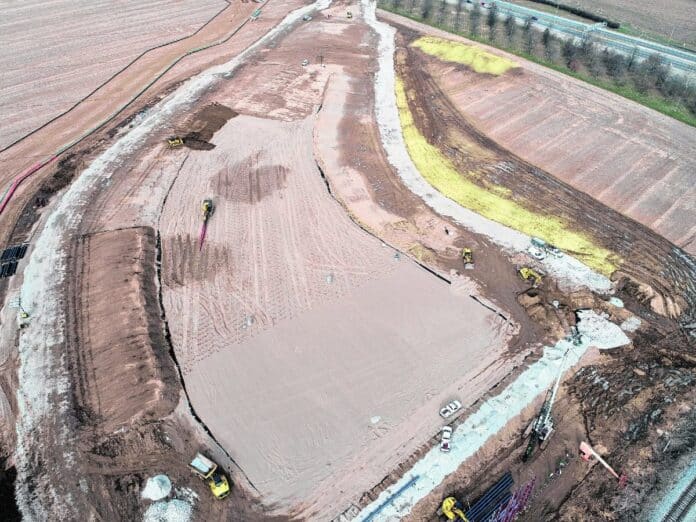
Heavy rain earlier this month has not significantly delayed construction work on the railroad overpass and interchange project on Columbus’ west side, although change orders have slightly impacted the cost of the project.
The $35 million overpass being built at State Road 46 and State Road 11 on Columbus’ west side will prevent traffic from being stopped at the railroad crossing there as train traffic increases on the Louisville & Indiana tracks. Construction on the project began in November and is expected to be completed by spring 2021, although landscaping and other finishing work will continue through 2021.
Currently, 40,000 motorists cross the railroad tracks at this intersection daily. To put it in perspective, an estimated 45,000 people live in Columbus, and 80,000 individuals live in Bartholomew County.
Louisville & Indiana has leased the tracks to CSX, and, after a massive rail improvement project, is planning to run high-speed rail on the line from Louisville to Indianapolis.
[sc:text-divider text-divider-title=”Story continues below gallery” ]
From Jan. 10 to 12, much of central Indiana received around 4 inches of rain — including 2.9 inches in Bartholomew County — causing the East Fork White River to flood near State Road 11 in and around the site of the $35 million project, according to the National Weather Service.
State Road 11 in the Garden City area south of State Road 46 was temporarily closed due to high water, which flooded two of the three sources of dirt that Milestone Contractors was using for the project, said Nathan Gaskill, project director at Milestone Contractors.
But even with that rain, the project, which is being jointly funded by the Indiana Department of Transportation, city of Columbus, Bartholomew County, Cummins Inc. and the Louisville & Indiana and CSX railroads, is still on pace to be open to traffic in spring 2021, INDOT officials said.
“(The weather) has not altered any timelines,” Gaskill said. “We got started right out of the gate, but the flooding closed off some of our material sources. …Some of the sources where we got the material flooded out and we’re currently de-watering them.”
Over the past month, construction crews have been laying the groundwork for the overpass and interchange, including completing ground stabilization tasks, drainage and storm sewer installation and some work on bridge components, Gaskill said.
Additionally, workers have installed around 4,000 wick drains, which help remove water from the ground, Gaskill said.
This week, workers have been able to start transporting dirt from all three sources — two pits on State Road 11 in Bartholomew County and one site on Indianapolis Road in Columbus — to the construction site for the first time since the flood, Gaskill said.
Milestone hopes to transport, on average, around 6,000 cubic yards of dirt to the site every day, Gaskill said. The total amount of dirt needed for the project is estimated to be around 460,000 cubic yards.
INDOT Seymour District spokeswoman Natalie Garrett said construction crews have used some built-in non-workable days and focused on tasks not impacted by inclement weather to avoid delays in the project’s timeline.
“The project is still progressing on schedule despite the wet weather we’ve had recently,” she said. “Weather has been a factor, but crews have been able to work in other areas to mitigate any type of delays. We also have some non-workable days built into the project schedule to allow for inclement weather, especially during the winter months. Flooding near (State Road) 11 did slow work for a couple of days, but there were no significant impacts to the project or schedule.”
Additional challenges
Construction crews have faced some additional challenges — including locating and removing an underground sewer force main with asbestos pipe and the wet soil.
As of Jan. 21, four change orders had been submitted to the city of Columbus totaling an estimated $137,883, though the city would be responsible for half of that amount, or $68,941, according to a change order summary presented to the Columbus Board of Public Works on Tuesday.
The lion’s share of the change order amounts involve the sewer force main and lime stabilization work, according to city records. The total for the lime stabilization work is $126,628, with the city’s portion being around $63,313. The total for the sewer force main work is $10,433, and the city’s portion would be around $5,216.
The funding for change orders would primarily come from the downtown TIF district, said Dave Hayward, city engineer.
The city, however, had a $261,434 credit with INDOT due to how the project’s agreement was structured, the bids received from contractors, among other factors, Hayward said. After the change orders, the credit would stand at $192,493.
In early January, workers used lime dust to dry and stabilize base soil on the project site before they started filling it with dirt, Gaskill said. The flooding did not affect the areas in which the lime stabilization work was done, he said.
“Once we lime-stabilized the base material, we started filling and putting borrowed dirt on top, so the flooding did not affect it,” Gaskill said.
Additionally, workers will attempt to remove the underground sewer force main to comply with INDOT requirements and prevent any future deterioration of the pipes, Hayward said. The removal of the sewer main will not impact local residents.
Sewer force mains are often used to transport wastewater from a lower point in altitude to a higher point, according to the Environmental Protection Agency.
“Utility locations are very critical out there,” Hayward told the Columbus Board of Public Works on Tuesday. “The big problem has been that (Columbus) City Utilities has a sanitary sewer force main that runs through the area. …(Construction workers) have spent a lot of time and effort to try to locate that. They’re still having trouble with parts of it, but I think they’re getting pretty close.”
Gaskill said workers have located the sewer force main on the east side of the railroad tracks, but are still searching on the west side. The main has not “derailed the project or caused a delay or anything like that,” he said.
Currently, the project is in the first of three phases. The first phase should be complete by the end of spring next year, according to INDOT. Traffic interruptions are expected to be “minimal” during this phase, Garrett said in a previous interview.
The second phase, which is expected to start in early summer and be completed by late fall, will result in temporary road and lane closures on State Road 11 and State Road 46.
In early summer, construction crews are expected to work on water mains, drainage structures and pavement on State Road 11, which is tentatively scheduled to be closed to all traffic for 30 days in June, Garrett said. Traffic on State Road 11 will be rerouted on to I-65 during that time.
In the fall, eastbound State Road 46 will be reduced to one lane for around 50 days to “allow construction of various tie-in points between the existing roadway and new roadway,” Garrett said.
During the the third phase of the project, which is projected to start in fall 2020, westbound State Road 46 will be reduced to one lane for about two months, according to INDOT.
Gaskill urged motorists to exercise caution in the construction zone.
“Please be aware of trucks entering and exiting. Give us a little extra room and reduce your speed,” Gaskill said.
[sc:pullout-title pullout-title=”Where to learn more” ][sc:pullout-text-begin]
To learn more about the railroad overpass project, visit columbusrailroadproject.org.
[sc:pullout-text-end]




